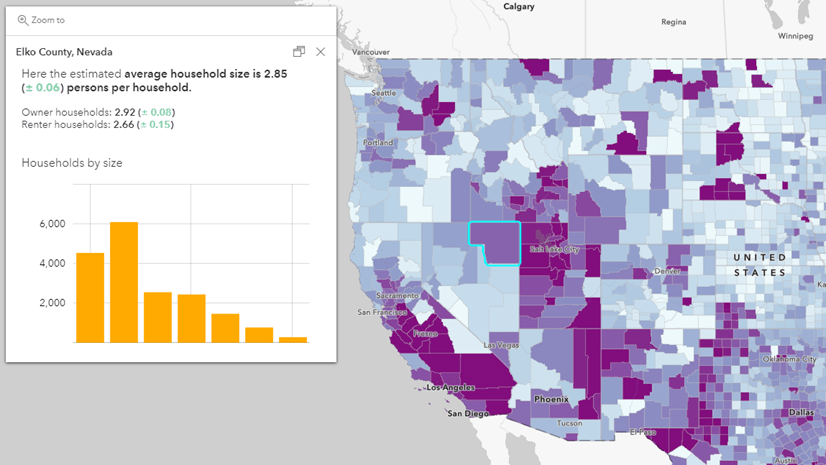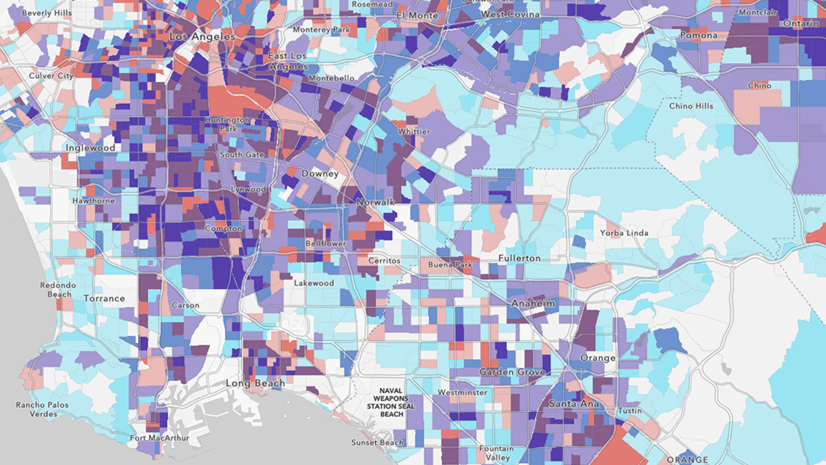The Living Atlas Policy Maps team maintains a set of layers that contain a wealth of data from the U.S. Census Bureau’s American Community Survey (ACS). On Dec. 10th, 2020, ACS will release the newest data values for their 5-year estimates. Within days of that release, the Living Atlas ACS layers will be refreshed with these new data values. This means that your maps will display the most recent data!
What’s Coming
More Layers Allow for More Mapping Possibilities
The Living Atlas ACS layers cover a whole host of topics around housing, income, internet access, education, disability, and more. We’ve heard your requests for more attributes you need to support your work. This December, there will be a few new additions to the layers that are available in the Living Atlas:
- Disability by Type – Map the functional needs of your community, such as hearing, vision, cognitive, ambulatory, self-care, and where independent living difficulties are high.
- Health Insurance by Race and Age – See where disparities are in rates of those who are uninsured. Find places where there aren’t large gaps.
- Household Size – Find communities with many 1-person households, 2-person households, and more. See how this differs among owners and renters. Map the average household size anywhere in the country.
- Housing Units Vacancy Status – Learn where there are many seasonal/recreational homes. Also, explore the rental and homeownership vacancy rates to see where these markets have been tight.
- Housing Units in Structure – Map different housing unit types in your community: single-family detached, small multifamily units, high-rise apartments, mobile homes, and more.
- Housing Units by Year Built – Where are newer housing units in your neighborhood? Where are older units? Does this differ for owners and renters?
- Internet Access by Income – See what the digital divide is like in your community.
2010-2014 Vintage for Many ACS Layers
A common refrain we hear from GIS and policy analysts is “I want to compare this to 5 years ago.” This December’s release of the 2015-2019 data will be the first time that three different comparable time periods will be available:
- 2005-2009 (first period ACS was published at tract level)
- 2010-2014
- 2015-2019 (most recent release)
We will be hosting a new ArcGIS Online Group of 2010-2014 boundaries layers version of our layers when the 2010-2014 data is available. Most of the ACS layers have comparable 2010-2014 data values, but not all. For example, the computer and internet questions were introduced after 2010, and therefore do not have any 2010-2014 estimates.
The 2010-2014 layers will be symbolized in the same way as their corresponding 2015-2019 layers, allowing for direct comparison of patterns within a map. Use the Compare App or create a swipe comparison within ArcGIS StoryMaps, Classic Story Maps, or ArcGIS Web AppBuilder to showcase the 2010-2014 map alongside the 2015-2019 version. Bring the two layers into Pro to join, analyze, and map the change itself. We will be publishing some detailed blog posts and tutorials on this closer to the time, so stay tuned!
Other Enhancements
- The boundaries layers will always reflect the TIGER boundaries that are appropriate for the newest ACS figures. In this December update, the 2019 TIGER boundaries will be swapped into the layers.
- Enhanced legends – many of the layers will have their cartography adjusted to highlight the national rate of the attribute being mapped. When this is the case, the legend will clearly state the national figure, helping create reference for the map reader.
- Revised aliases for race and ethnicity categories to be more consistent with the American Community Survey race and ethnicity categories as published by the U.S. Census Bureau.
- Refined margins of errors for calculated attributes based on feedback from the U.S. Census Bureau.
What’s Changing
Because ACS data reflects the ever-changing world around us, this can mean changes to ACS attributes over the years. Since these Living Atlas ACS layers match the attributes from the U.S. Census Bureau, some changes can be expected. The layers will reflect these new changes, but custom web maps created with any changed attributes will need to be updated.
Transportation to Work
The Census has changed the means of transportation to work classifications within the public transportation category in Table B08301. This means that some of the attributes will have new meaning in the ACS Transportation to Work boundaries and centroids layers. If you have a map using these layers, the FAQ for the ACS layers will soon contain more information about updating your maps for this change.
Child Living Arrangements
The Census has discontinued Table B09008, and restructured Table B09005. This means that some fields of the ACS Living Arrangements boundaries and centroids layers will be deprecated and new fields will be added. This will also be the case for our ACS Context for Child Well-Being boundaries and centroids layers. If you have a map using these layers, the FAQ for the ACS layers will soon contain more information about updating your maps for this change.
Using These Layers
Find the layers:
Learn where to find these layers and start using them within your mapping and analysis workflows. Check out this story map to learn how.
Get started:
Learn how to make a map about your community in 4 easy steps in this blog. You’ll have your own custom web map in minutes!
Update your existing ACS maps:
Whenever new ACS figures are released by the Census, we encourage you to check the breakpoints being used in your existing web maps that use the Living Atlas ACS layers. After the December release, make sure your existing map breakpoints still make sense with the updated data.
Questions?
If you have questions about the layers, visit our FAQ, or post on Esri Community’s Living Atlas space. You can also learn more about the layers in this blog.







Article Discussion: